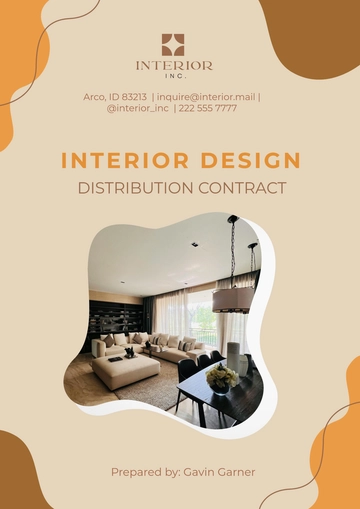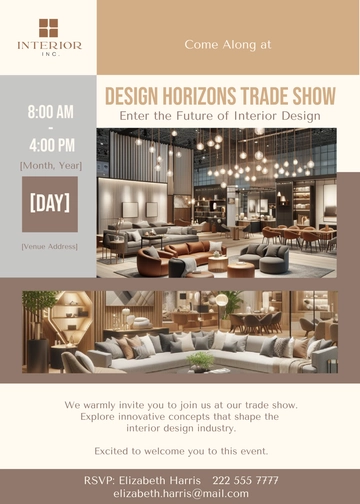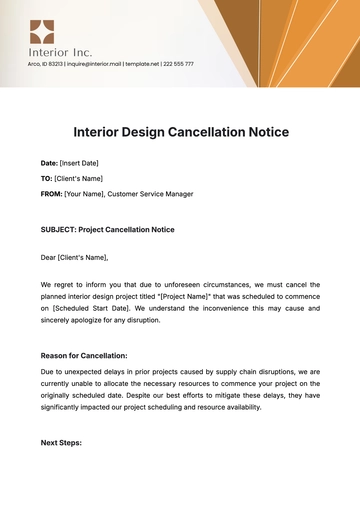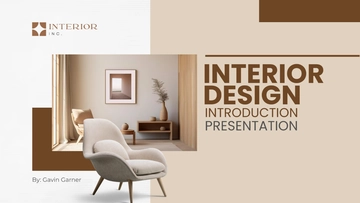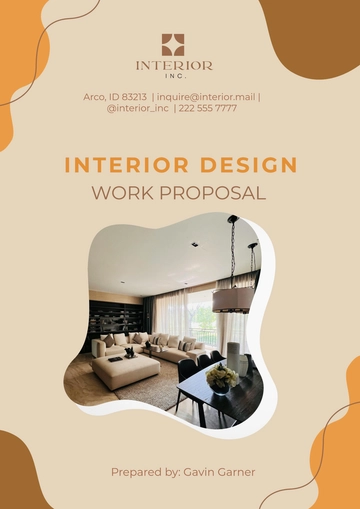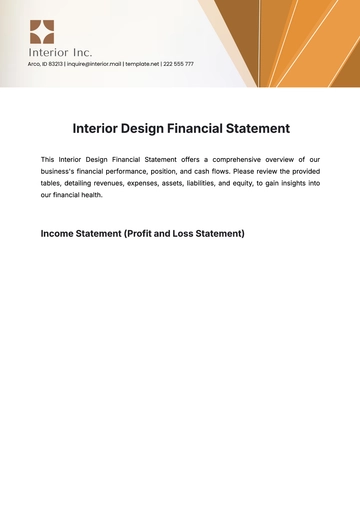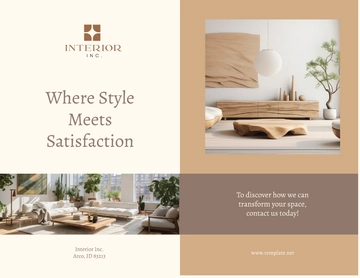Free Interior Design Management Policy

I. Introduction
At [Your Company Name], our commitment to excellence in interior design is reflected in our comprehensive management policy. This policy serves as the cornerstone of our operations, guiding every aspect of our work to ensure unparalleled quality, creativity, and client satisfaction. By adhering to this policy, we uphold our reputation as a premier interior design firm dedicated to transforming spaces into inspiring environments.
II. Mission Statement
[Your Company Name]'s mission is to elevate everyday living through innovative and personalized interior design solutions. We believe in the power of design to enrich lives, inspire creativity, and foster connections. Our goal is to exceed our clients' expectations by delivering exceptional design experiences that reflect their unique vision, lifestyle, and personality.
III. Core Values
Creativity: Creativity is at the heart of everything we do at [Your Company Name]. We encourage bold ideas, unconventional thinking, and imaginative solutions that push the boundaries of design.
Quality: We are unwavering in our commitment to quality craftsmanship, materials, and service. From concept to completion, we strive for excellence in every detail to ensure lasting satisfaction for our clients.
Collaboration: Collaboration is key to our success. We believe in the power of teamwork, open communication, and mutual respect. By collaborating closely with clients, suppliers, and team members, we create synergy and achieve remarkable results.
Integrity: Integrity is the foundation of our business. We conduct ourselves with honesty, transparency, and ethical integrity in all our interactions. Trust and integrity are non-negotiable principles that guide our decisions and actions.
Innovation: At [Your Company Name], we firmly believe that innovation is the primary catalyst for progress. We are committed to embracing change and staying ahead of emerging trends, ensuring that our design approach undergoes continuous evolution. By integrating new technologies, adopting advanced materials, and implementing cutting-edge methodologies, we maintain our leading position at the forefront of the industry.
IV. Client Engagement
Consultation: We begin each project with a thorough consultation to understand our client's needs, preferences, and aspirations. We believe in active listening and open dialogue to ensure a deep understanding of the project requirements.
Concept Development: Based on the insights gained from the consultation, our design team develops initial concepts, mood boards, and sketches to illustrate the proposed design direction. We encourage client feedback and collaboration to refine and tailor the concepts to their vision.
Design Presentation: We present the finalized design concept, including 3D renderings, material samples, and mood boards, to provide clients with a clear visualization of the proposed design. We welcome feedback and revisions to ensure alignment with the client's expectations.
Project Implementation: Once the design concept has received approval, we initiate the implementation phase in which we take control over every facet of the project. This comprehensively includes the procurement of materials, the construction process, and the installation procedures. Our project managers are committed to providing meticulous coordination and adhering to strict timelines, thereby ensuring the seamless progression and successful completion of the project.
V. Design Process
Programming: We begin by conducting a comprehensive analysis of the project requirements, site conditions, and user needs. This includes understanding the functional objectives, spatial constraints, and aesthetic preferences of the client.
Conceptualization: Based on the programming phase, our design team generates initial design concepts, exploring different spatial layouts, color palettes, and material selections. We present these concepts to the client for feedback and refinement.
Design Development: Once a concept is approved, we proceed with the detailed design development phase. This involves refining the design details, selecting materials, finishes, and furnishings, and developing technical drawings and specifications.
Documentation: We produce comprehensive documentation, including floor plans, elevations, sections, schedules, and specifications, to guide the construction process. Clear and detailed documentation is essential for ensuring accuracy and consistency during the build phase.
Construction Administration: Throughout the construction phase, we provide onsite supervision, contractor coordination, and quality control to ensure that the design intent is faithfully executed. We address any issues or changes promptly to maintain project momentum and quality standards.
VI. Project Management
Team Allocation: We assign dedicated project managers and design teams to each project to oversee all aspects of the project lifecycle. Our project managers serve as the primary point of contact for clients, ensuring clear communication and seamless coordination.
Timeline Management: We develop detailed project schedules and milestones to track progress and ensure timely completion. Our project managers closely monitor timelines and proactively address any delays or obstacles to keep the project on track.
Budget Oversight: We work closely with clients to establish realistic budgets and manage project costs effectively. Our project managers conduct regular cost analysis, value engineering, and procurement strategies to optimize budget allocation and minimize expenses.
Quality Assurance: We maintain rigorous quality control measures throughout the project, conducting regular inspections and quality checks to ensure that workmanship and materials meet our standards of excellence. We address any quality issues promptly to uphold our reputation for quality and reliability.
VII. Supplier and Vendor Relations
Selection Criteria: We carefully select suppliers and vendors based on their reputation, reliability, quality of products, and alignment with our values and standards. We prioritize partners who share our commitment to excellence and sustainability.
Negotiation and Contracts: We negotiate favorable terms, pricing, and contracts with suppliers and vendors to ensure cost-effectiveness and timely delivery of materials and furnishings. Clear and transparent communication is essential for building strong and mutually beneficial partnerships.
Partnership Development: We cultivate long-term relationships with preferred suppliers and vendors, fostering mutual trust, collaboration, and innovation. By nurturing these partnerships, we ensure access to high-quality materials and resources that enhance our design capabilities.
VIII. Sustainability and Environmental Responsibility
Material Selection: We prioritize eco-friendly and sustainable materials, products, and practices in our design projects. This includes selecting materials with low environmental impact, such as recycled, renewable, or locally sourced materials.
Waste Reduction: We strive to minimize waste generation and maximize recycling and reuse opportunities throughout the design and construction process. This includes implementing waste management strategies, such as salvaging materials and recycling construction debris.
Energy Efficiency: We integrate energy-efficient technologies and design strategies to optimize building performance and reduce energy consumption. This includes incorporating natural daylighting, energy-efficient appliances, and HVAC systems to minimize environmental impact and operating costs.
IX. Health and Safety
Regulatory Compliance: We comply with all relevant health and safety regulations and standards to ensure a safe and healthy work environment for our team members and clients. This includes adhering to building codes, fire safety regulations, and occupational health guidelines.
Risk Management: We identify and mitigate potential health and safety risks through proactive hazard assessments, safety training programs, and emergency preparedness measures. Our goal is to create a safe and secure environment for everyone involved in our projects.
X. Continuous Improvement
Feedback and Evaluation: We actively seek feedback from clients, team members, and stakeholders to identify areas for improvement and innovation. This feedback is used to evaluate our performance, identify strengths and weaknesses, and implement corrective actions and process enhancements.
Professional Development: We invest in ongoing training and professional development opportunities for our team members to enhance their skills and knowledge. This includes attending industry conferences, workshops, and seminars to stay abreast of emerging trends and best practices.
Innovation and Research: We encourage innovation and research to explore new design trends, technologies, and methodologies. This includes investing in research and development initiatives, experimenting with new materials and techniques, and collaborating with industry partners to drive innovation and creativity.
XI. Conclusion
At [Your Company Name], we are wholly committed to establishing ourselves as the benchmark for outstanding achievements in the field of interior design. Our dedication to this goal is reflected through our thorough management policy which is foundational in maintaining our pledge towards fostering creativity, ensuring quality, enhancing collaboration, upholding integrity, and encouraging innovation.
Our steadfast adherence to these core principles, coupled with our relentless pursuit of excellence, empowers us to not only meet but exceed the expectations of our clients. By doing so, we continually affirm our status as a pioneering leader within the industry.
- 100% Customizable, free editor
- Access 1 Million+ Templates, photo’s & graphics
- Download or share as a template
- Click and replace photos, graphics, text, backgrounds
- Resize, crop, AI write & more
- Access advanced editor
Ensure smooth operations with Template.net's Interior Design Management Policy Template. Editable in our AI Editor Tool, this customizable template ensures clarity and consistency in your management approach. Crafted for efficiency and effectiveness, it streamlines your policy documentation, covering procedures, standards, and protocols. Simplify your management practices with this essential resource.

